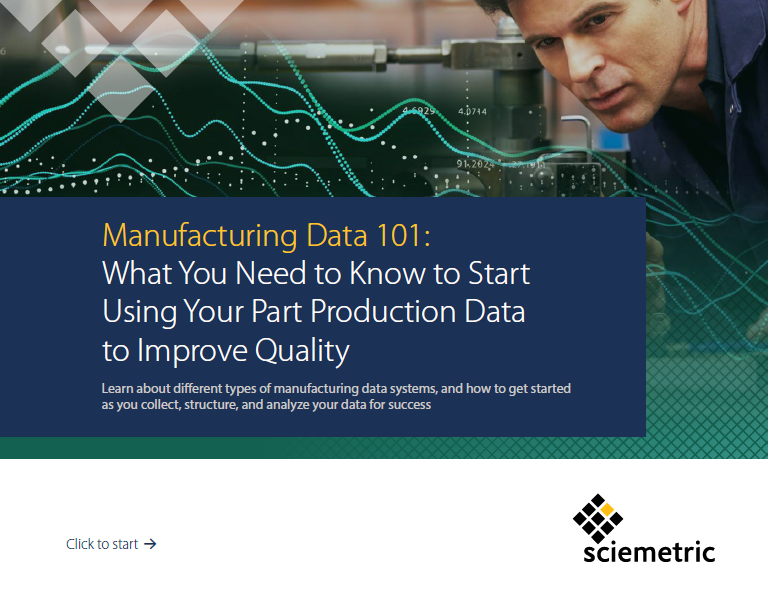Contributed by: Sciemetric Staff

Many manufacturers are embracing the power of using production data to improve their product quality and make other efficiency improvements on their lines. But with so many different types of manufacturing data systems on the market, it can be difficult to identify what type of system will serve your line best.
Types of Manufacturing Data Systems
Let’s explore a few of the different types of manufacturing software solutions available and their uses.
OEE (Overall Equipment Effectiveness)
OEE has long been considered a gold standard for measuring manufacturing productivity. At its simplest, an OEE system monitors machines to predict issues before downtime occurs. OEE is a useful tool for managing the health of a machine, managing its maintenance schedule and getting to the root cause of a tooling problem.
MES (Manufacturing Execution System)
MES delivers a more comprehensive focus on manufacturing processes and efficiencies than OEE. MES does so by capturing data related to machines and people in product quality and throughput.
A typical MES system tracks and documents the transformation of raw materials to finished goods with the goal to understand how current conditions on the plant floor can be optimized to improve production output.
Statistical Process Control (SPC)
SPC uses statistical tools to monitor trends in production parameters to spot deviations that may eventually result in rejects. When recorded process data falls within present control and specifications limits, it indicates that the manufacturing process is operating as intended.
Operational Historians
Many plants also rely on process data that is time-based, instead of tracked by the serial number of the part or assembly in production, using database software applications called operational historians. Historians capture plant management information about production status, performance monitoring, quality assurance, tracking, birth history, and product delivery.
Part-Focused Test & Process Data Acquisition & Analysis
This type of system provides data on all elements of a test process or operation, focusing more on what is happening to the serialized part than machine performance. It is used to provide a more detailed account of the processes a part goes through during the manufacturing process. Data is collected using sensors such as load-cells, temperature, position and pressure sensors, microphones or displacement gauges at critical-to-quality stations.
This data can then be made available for analysis. When the data points deviate outside the set test limits, this signals a problem likely to impact product quality. This rich data can also later be mined to trace the root cause of a quality issue, resolve issues quickly, or optimize production.
Learn more about this kind of manufacturing data system: https://www.sciemetric.com/studio
Avoid gaps in your data strategy, identify your manufacturing challenges and goals
Each of the above tools fulfil a different purpose in managing the health of a production line. Choosing the right mix of capabilities depends upon the challenges you want to use data to solve and it’s important to consider where the gaps may be.
An MES, for example, can collect test data for a part, but it’s typically only a few key measurements. If the objective is to use the data for root cause analysis on a quality issue or find ways to reduce test cycle time, this will be insufficient for the task.
Sciemetric’s manufacturing data system—designed to solve manufacturer’s challenges
In-Process Digital Signatures + SPC-Enabled Real-Time Alerts
Sciemetric’s manufacturing data solutions are designed to meet the needs of the manufacturers we work with every day. To do this, we combine part-focused test data insights in the way of in-process digital signatures with SPC capabilities and real-time alerts. Our solution is designed to alert you as soon as there is a deviation on a monitored process and then provide you with a fast, clear path from analysis to answer so you can quickly identify the root cause of a problem and make changes to your process to avoid the problem in the future. Learn more >
Want to learn more? Download our free e-book:
In this e-book, we cover the basics of what you’ll need to know to get started with manufacturing data.
What you will get out of this e-book:
- How Much Data to Collect, Which Data to Collect, and How Long to Keep it
- How to Structure and Consolidate the Data
- Different Types of Manufacturing Data Tools
- Checklist: What To Look For When Choosing Manufacturing Data Solutions
- How Sciemetric Can Help You Get Started with Data Collection & Analytics


